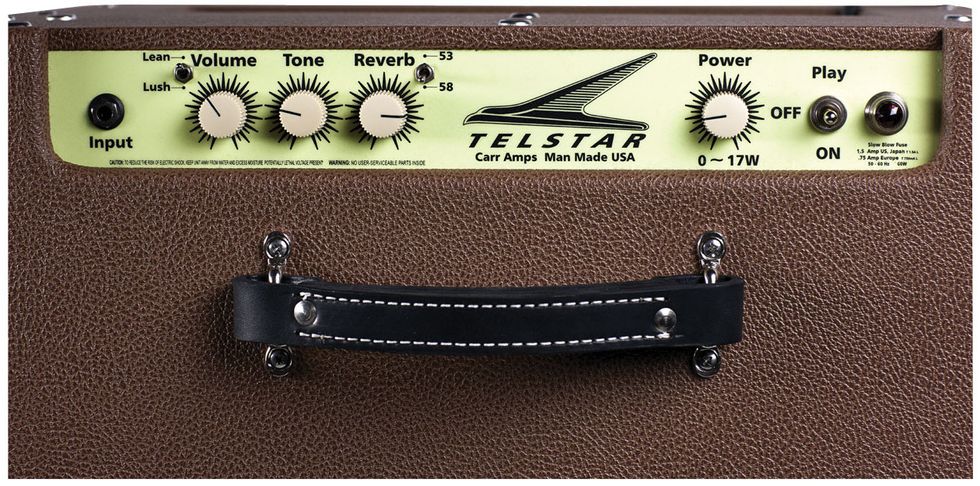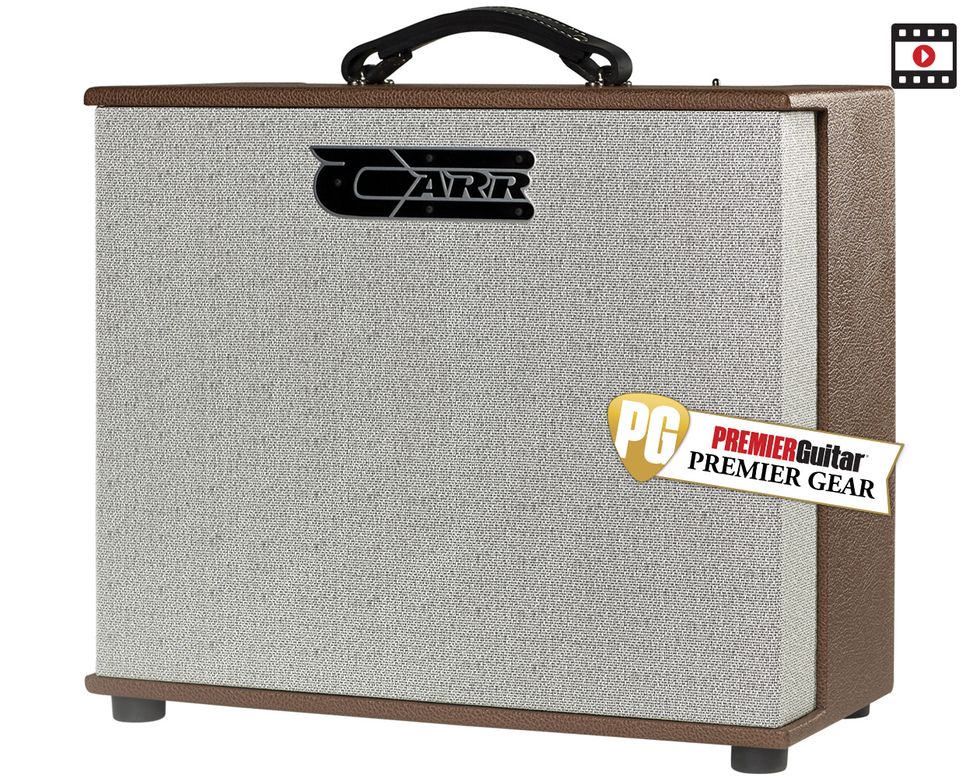RatingsPros:Magnificent tones at all settings. Simple yet versatile controls. Wide dispersion. Top-shelf parts. Killer looks. Innovative circuit design. Cons: Pricey. Street: $2,390 street ($2,490 as tested in custom color) Carr Telstar carramps.com | Tones: Ease of Use: Build/Design: Value: |
The latest creation from North Carolina amp builder (and PG columnist) Steve Carr is a 17-watt, 1x12 combo that fuses vintage Fender and Vox designs while adding welcome modern updates and characteristically Carr details.
Mid-Atlantic Accent
Carr’s amps have roots in ’50s and ’60s creations, yet they’re far from clones. His Skylark, for example, is a freewheeling spin on the old Fender Harvard, while his Lincoln partially echoes the Vox AC15. But Telstar takes a different tack. It employs two familiar power tubes that, as far as I know, have never been paired: a 6L6 (used in many large and midsized Fender amps) and an EL84 (ubiquitous in Vox tube amps). The result, in brief: the presence and immediacy of a great tweed, the thrilling sparkle of Vox overdrive, and tighter, tougher bass response than you’d expect from a strictly vintage midsized combo.
You can substitute an EL34 or 6V6 for the 6L6 without modifications or re-biasing, though I didn’t test those options. The preamp tube is an octal 6SL7, an oddball choice that appeared in some vintage Ampeg and Valco amps. A spring reverb, which has a suave early-Fender flavor, employs a 12AX7/12AT7 pair. The rectifier is solid state.
Filling the Room
The first thing I noticed after plugging in was how Telstar fills the room. With its relatively thin solid-wood cabinet (Steve Carr constructs his own cabinets) and Carr-branded 60-watt Valiant speaker, the amp disperses sound widely and evenly. It simply sounds big. It’s loud, too. There’s enough volume for most small club gigs without miking the amp. Telstar’s strong note fundamentals and articulate attack provide clearer tones at louder levels relative to most amps of similar power.
Mid-Century Style
Telstar has an understated, mid-century minimalist look. Gone are Carr’s signature asymmetrical speaker cutouts. Instead, the grille cloth nearly covers the amp’s front surface and wraps around both sides. The design is simple, yet attractive.
But “simple” is the last word you’d use to describe Telstar’s interior. Like all Carr amps, it’s 100-percent handwired, with no circuit board or turret board. It looks chaotic, with components suspended between terminals and secured with glue-gun blobs. But a few pokes with a (non-conductive!) chopstick confirm that everything is secure. The components are strictly top-shelf, including hefty custom-spec Carr-branded transformers, Jupiter tone caps, and Solen power supply caps. I remain agnostic about the sonic benefits of point-to-point wiring, and I don’t know that Telstar would sound any less lovely with a more conventional build. But damn, it sounds good.
Stupid-Proof Controls
Telstar’s control panel is disarmingly simple. Its only knobs are volume, tone, and reverb amount, plus a power attenuator. The single tone control provides the assertive midrange of a good Fender tweed, as opposed to the scooped-mid profile of later blackface Fenders. Clip 1 demos various settings. (The guitar is a “parts” Strat with Lollar Firebird pickups.) The power attenuator works beautifully. High-gain sounds at low levels display little, if any, tone loss relative to full power.
Toggle Time
There are two additional wrinkles: a lean/lush switch and 53/58 toggle. Lush is a full-frequency sound, while lean siphons off lows between 100 and 200 Hz. The lean setting is brighter, cleaner, and more articulate when overdriven. You might, for example, use lush mode for rich, clean-toned chords, but use lean to maintain definition for high-gain solos.

I wish more amps had this feature. According to Carr, the 53/58 switch toggles between an early-’50s tweed circuit and something closer to a late-’50s Bassman. The remaining audio clips demonstrate these unconventional controls. I direct-recorded a single guitar phrase and then reamped it back through Telstar, moving controls between repetitions.
Clip 2 demos the four possible toggle configurations: Lean 53, Lean 58, Lush 53, and Lush 58, in that order. With the tone knob at noon, 58 mode is a bit gainier, darker, and louder.
Clip 3 demonstrates the range of the single tone control in 53 mode, first with the tone pot at minimum, then at noon, and finally at maximum.
Clip 4 is identical, but in 58 mode. Paired with the bass-cutting lean setting, the tone knob provided all the control I wanted.
The Verdict
I’ve described Telstar as objectively as possible. Now I’ll let my heart speak: I love this frickin’ amp. The tones harken back to vintage Fender and Vox combos without mimicking them—Telstar’s voice is retro, yet unique. The touch response is off the charts. The deceptively simple controls offer many fine tones. Still, I can imagine users parking the knobs near noon and making tonal adjustments entirely from their guitars. Clean tones glow. Distortion is complex and articulate. At $2,450, Telstar is pricy. But that buys an amp with a unique voice, high-end and custom-spec parts, an exceptionally labor-intensive build, and all the R&D this innovative design must have required.
Watch the First Look:









![Rig Rundown: Russian Circles’ Mike Sullivan [2025]](https://www.premierguitar.com/media-library/youtube.jpg?id=62303631&width=1245&height=700&quality=70&coordinates=0%2C0%2C0%2C0)

















